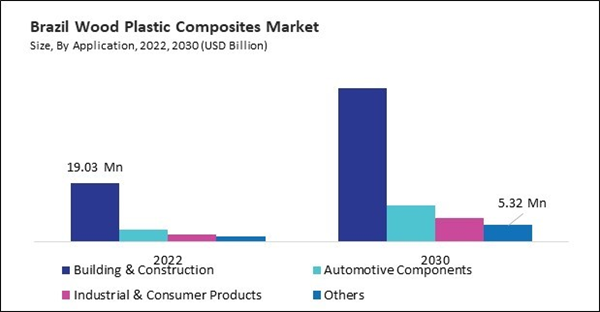Polyethylene plays a crucial role in the wood plastic composites (WPC) market as it serves as one of the primary plastic components in these composite materials. In WPC production, polyethylene, a type of plastic derived from ethylene, is often used as a matrix or binder that holds together the wood fibers or flour. Its versatility allows it to be combined with wood particles in various forms, such as pellets or powders, to create a homogeneous mixture. Therefore, the Brazil market consumes 67.5 kilo tonnes of Polyethylene in 2022.
The Brazil market dominated the LAMEA Wood Plastic Composites Market, by Country in 2022, and would continue to be a dominant market till 2030; thereby, achieving a market value of $234.4 Million by 2030. The Argentina market is showcasing a CAGR of 13.4% during (2023 - 2030). Additionally, The UAE market would register a CAGR of 12.4% during (2023 - 2030).
Design innovation and customization drive demand for WPC as manufacturers seek to differentiate their products through unique aesthetics, textures, colors, and finishes. WPCs offer design flexibility and versatility, allowing for replicating natural wood grain patterns, embossed textures, and customized surface treatments to meet diverse architectural and consumer preferences.
Customization of color options and finishes allows WPC manufacturers to offer personalized solutions tailored to individual preferences and project requirements. Colors ranging from earthy tones reminiscent of natural landscapes to vivid tints that enliven outdoor areas are among the many options for selecting and personalizing WPCs. Additionally, innovative finishing techniques such as matte, gloss, or semi-transparent coatings enhance WPC products' durability, UV resistance, and longevity while maintaining aesthetic appeal and color vibrancy over time.
Saudi Arabia has increasingly prioritized sustainability and environmental conservation as part of its national agenda and Vision 2030 objectives. As per the data from the International Trade Administration, the automotive sector in the Middle East and North Africa (MENA) region is currently experiencing a 36% growth rate, with Saudi Arabia emerging as the primary industry in the area. Saudi Arabia accounted for approximately 52% of vehicles sold in the Gulf Cooperation Council and 35% of vehicles sold in the MENA region in 2020. In 2019, 556 thousand vehicles were sold in Saudi Arabia; in 2020, 436 thousand vehicles were sold. The projected sales figure by 2025 is 543,000 units. Therefore, with the growing construction and automotive sectors in LAMEA, there will be increased demand in the regional market.
Based on Type, the market is segmented into Polyethylene, Polyvinyl Chloride, Polypropylene and Others. Based on Application, the market is segmented into Building & Construction, Automotive Components, Industrial & Consumer Products and Others. Based on countries, the market is segmented into Brazil, Argentina, UAE, Saudi Arabia, South Africa, Nigeria, and Rest of LAMEA.
List of Key Companies Profiled
- Trex Company, Inc.
- The AZEK Company Inc. (TimberTech)
- Fortune Brands Innovations, Inc.
- Dow, Inc.
- UFP Industries, Inc.
- Renolit SE
- AIMPLAS
- JELU-WERK J. Ehrler GmbH & Co. KG
- FKuR Kunststoff GmbH
- Beologic
Market Report Segmentation
By Type (Volume, kilo Tonnes, USD Billion, 2019-2030)- Polyethylene
- Polyvinyl Chloride
- Polypropylene
- Others
- Building & Construction
- Automotive Components
- Industrial & Consumer Products
- Others
- Brazil
- Argentina
- UAE
- Saudi Arabia
- South Africa
- Nigeria
- Rest of LAMEA
Table of Contents
Companies Mentioned
- Trex Company, Inc.
- The AZEK Company Inc. (TimberTech)
- Fortune Brands Innovations, Inc.
- Dow, Inc.
- UFP Industries, Inc.
- Renolit SE
- AIMPLAS
- JELU-WERK J. Ehrler GmbH & Co. KG
- FKuR Kunststoff GmbH
- Beologic
Methodology

LOADING...









